
The enigma of Giorgione
By Ali Smith
Published on 7 March 2016
Giorgione left few clues to his life, yet he was at the heart of a creative explosion in 16th-century Venetian painting that changed the course of European art. Ali Smith brings to life the fusion of originality and poetry in his work.
From the Spring 2016 issue of RA Magazine, issued quarterly to Friends of the RA.
What is this a picture of? It’s called Il Tramonto (The Sunset). Its title was given to it just last century, by the great Renaissance critic and writer, Roberto Longhi. But the painting existed for 400 years or so without this title.
Is it of, or about, a sunset? Below centre, in the shade under a spare and spindly poplar or mountain ash, a couple of men, an older man and a younger, are sitting on rocks and on the ground. The younger man seems to be looking pensively down or maybe writing something in the actual earth or on the rock surface on which he’s sitting. The older man, below him – is he a servant? He seems to be massaging the younger man’s leg. There’s a stick on the ground – a walking stick? – and what looks like a little barrel, maybe water or wine. Is this a picture of a rest-stop on a journey? Behind and above, to the right of the couple on another rocky little promontory or stage, there’s a knight on a horse, made tiny by perspective, and it looks like St George, since he’s lancing a (rather unimpressive sized, if creepily tentacled) dragon to death, and there, behind this in the shadows, there’s a figure emerging from a cave. Is it a St Anthony? There’s a great deal going on in the shadows. Below, in the murky pond next to the old and young man, there’s what looks like a pig poking out of its own water’s-edge cave (which would comply with St Anthony, since pigs, caves and St Anthony often come together in Renaissance stories and figurings), but the pig is the least of the water’s beastliness, since those dark rocks in the foreground of the water might be a monster and there’s a Bosch-looking bird with an angry beak emerging at the shore near the men. The rocks on the other side of the men, under a sheaf of very dark foliage, have ghoulish faces. Or is it just random rock alignment?
Is this a picture of saints, then? Of hell? Of a psychological landscape? Of a realism edged with and ignoring icons and omens? Of a mythical story where an old man tends to a young lame man? Is it about servitude? Innocence and learning, hidden grotesqueries and dangers? Leaving a mark on a landscape, or on nature, as we pass through it, or, more correctly, below it? Putting all this adventuring, iconographing and questioning in the shade, even with so very few leaves and branches to do it, is the figure held at the true centre of the picture, the spindly, graceful curve of a tree, aloft above realisms, allegories, nightmares and saints with a kind of untouchable elegance, behind it a rolling tawny landscape of fields, buildings, a harbour, an opening wedge of brightness where the picture suddenly surges off to the side into blue, a blue that’s brighter and more uncanny than the sky’s blue which is itself lit with an underscore of gold, and the promise of an intenser gold just slipping out of it at its left edge.
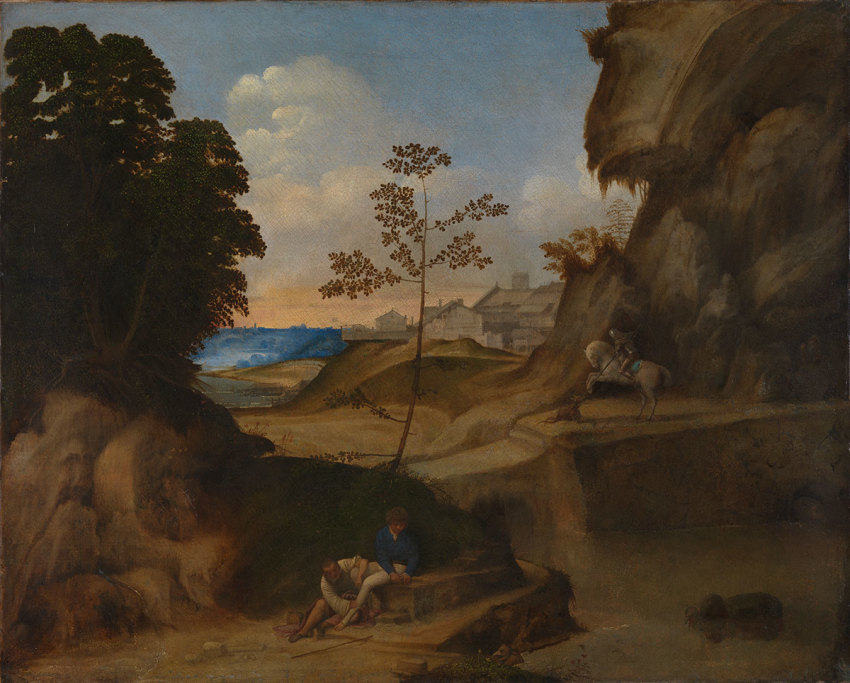
There’s no denying it – this slimmest of trees, and the slabs and waves of colour that open behind and above it, are the subject of this painting, regardless of all its dramas, above its realisms, stories, religious and psychological iconographies, in fact making them all seem small, approximant, near laughable, and making even things happening in the picture’s foreground, in front of the tree, act like background to it.
So: is this a picture of a tree? Is it of the painted tree as a triumphant yet subtle mirror of the real, and of nature’s dominance when it comes to notions of reality, meaning, image and narrative? Of art’s relationship with fixed narratives? Of the dying light of certain aesthetic practices and the rising grace and splendour of new ways of seeing, new ways of painting?
We don’t know much for sure about its painter, the early 16th-century Venetian, Giorgione. We don’t even know for definite that this picture is by Giorgione (and there’s also evidence of fairly recent substantial restorative retouching by others to take into account). But there’s one story told – and there aren’t that many about him, so it’s interesting that this one turns up twice, once in Paolo Pino’s 1548 Dialogo di Pittura and once 20 years later in a slightly different form, in Giorgio Vasari’s second edition of his Lives (1568) – where the painter is having an argument with some sculptors, who insist that sculpture is the superior art since painting can only ever “represent only one aspect of any given subject”:
Giorgione argued to the contrary that in a single scene the painter could show to an observer standing still in one place various aspects of the one figure ... He painted a man in the nude with his back turned and, at his feet, a limpid stream of water bearing his reflection. To one side was a burnished cuirass that the man had taken off, and this reflected his left profile (since the polished surface of the armour revealed everything clearly); on the other side was a mirror reflecting the other profile.
What a witty dimensionalising. This telling of it by Vasari echoes Pino’s earlier version, one of trees with mirrors propped against them to reveal an ingenious simultaneity, except that Pino says the figure Giorgione depicts standing in the stream is St George. In Vasari’s version the saint has become just a man, one whose nakedness is reflected in his own armour, and this is somehow even more apt when you consider the transparent opacity, the enigmatic openness, the mix of strength, reflection and unadorned nature in the brand new and many-aspected dimensionality that Giorgione brought both to the narrative of landscape and the handling of portraiture in the very short time of his working career. If this playful picture ever existed, it’s now nothing but dust. So much of Giorgione’s work is lost, so much of what’s attributed to him is unprovable, so few of the works we call Giorgione’s can be attributed because so little was signed and so little verification remains in other forms.

But from so few extant works, what a tradition of open possibility has arisen, not just in terms of Giorgione’s new figurations and his innovations in tonal structuring, but in terms of continuing, centuries-long, aesthetic and philosophical discussion about what a painting is and how to read images at all. It’s a tradition that’s still fertile in its very quarrelsomeness about the mystery man himself, the mysteries of attribution and worth, and the mysteries all through his works, still all the centuries later emanating their magnetic elusiveness.
A sense of myth began to develop round this mysterious, hugely influential young painter almost from the moment of his death, which was in the autumn of 1510 and probably of the plague. He was in his early 30s, and seems to have been working as a painter in Venice since the turn of the century, though with no verified master or workshop and with only a couple of public commissions; his work seems largely to have been privately commissioned. (And in this he is a heralder of the private work and the private collection industry: a few days after his death, Isabella d’Este tries her best to buy a Giorgione painting she’s heard about, but her contact in Venice reports back how difficult it will be to get hold of anything since all the pictures he knows of are privately held by people who loved Giorgione so much that they’re unlikely to want to sell.)
Vasari’s versions of Giorgione’s life differ so dramatically in the different editions of the Lives that this is itself literal proof of the recognised and growing importance, decade by decade across the 16th century, of Giorgione’s posthumous stature. He tells us he was born “of humble background” in the late 1470s in Castelfranco, not far from Venice where he grew up; it seems Giorgione was as much an inheritor of Venice as Venice was of him. Surely his love of reflection, of the shift of light on surfaces, comes from the glittering city itself; surely the undeniable synthesis of originality and poetry in his work is born of an environment of fertile explosion in all the creative industries, the printing revolution, new possibilities in glass, ceramics, textile colour and colour-making itself, and a time of a prevailing humanism which brought the arts into fusion with each other and with the city’s own architectural and aesthetic versions of itself.

Vasari stresses his delightfulness, that he loved love itself, and women, society and music, that he was so good a lute player and singer that he kept getting invited to entertain “gatherings of noble persons”, and that though he picked up notions of how to use darkness and light from Leonardo, he went on to become so strikingly original, working “directly from life”, that his paintings sent shock waves through all the painters in Venice, “greatly surpassing” them all and rivalling those concerned with “creating the modern style”. The story ends when he contracted the plague from a “certain lady” (this unsourceable story later swells into a myth of its own with versions of doomed romantic Zorzi dying of despair at the death of his beloved) but never mind, Vasari says, because he left us his “accomplished pupils”, one of whom was Titian, who “far surpassed” Giorgione’s talent in the course of his own life (or Life). There’s a sense in which Vasari almost enjoys the succumbing of the young too-delightful groundbreaker whose style was unencumbered by the old styles and free from everyone else’s styles, and whose work, born so much of “his own fancy”, was so annoyingly strange, original, unlike anyone else’s as to be puzzling, elusive: “I for my part have never been able to understand his figures... heaven knows what it all means.”
What it means to look at a Giorgione landscape is to see a painting that acts at the same time like other arts – as if a painting could be at the same time a piece of music you experienced sensorily, or a book, or a poem, and could ask you to read it, to come to its language open, to accept not knowing everything yet and to find yourself engaged with and questioning both the art and the life in it. What it means to encounter a portrait by Giorgione is to encounter a vision of a person as a faceted being, aspect after potential aspect, mysterious and readable/ unreadable at once – as we truly are to each other. Portraits attributed to Giorgione have a tendency to emphasise a living moment, be lit with a transience that fills it with vitality – maybe a person caught on the edge of a word, often mouth open on that word, maybe someone turning for a moment towards the viewer or paused in throwing a glance or holding a gaze just slightly askance. The knight in one portrait attributed to Giorgione, Knight and Groom (pictured), has turned for that moment, slightly jaunty, towards us, caught to one side, which makes him a little dandified, vulnerable even, regardless of the baleful beauty, the arrogance and determination in both his face and the display of his war tackle, his gold-silver shining armour and his apparent surety of belief, his hand on the cross of his rather fine sword. The boy standing or moving behind him (a reminder of the man’s own boyhood only just behind him) is either in mid-song, or has seen, is seeing, something arresting and maybe even petrifying; either way, both are fixed on their courses, both in kinds of trance, and the knight is only throwing us the gift of a glance as he goes.

Portrait of a Young Man ('Giustiniani Portrait'), c. 1497-99

Portrait of an Archer,
Portrait of an Archer (pictured) is more self-reflective, quite literally so with the gloved hand doubling in his armour on his chest in a parallelled strength and fragility even down to the ungloved finger, thumb and wrist-skin appearing through the material. Is this a picture of an archer, or a picture of a lover, of a soul in a hard shell? The armour itself is softened by the red suggestion of the ribbon at the shoulder. What is he saying, the man in the picture? He’s indicating himself, as if through himself to his true self, and all in that passing glance. Perhaps part of the mystery of Giorgione resides in the engima of such independent work – and the fact that each painting, rather than being of someone or something, seems to have been made on its own terms and to be looking at us rather than the other way round. Perhaps it comes from the freedom with which Vasari notes he painted, both in the technical action of the work and in the freelancing way he created work. Perhaps this double freedom resulted in work which is, at core, even free of its artist.
When he painted an Adoration, he had that freedom of vision and construction, both, to move the crib and holy family a little to one side and to focus his picture on the usually sidelined, the shepherds (Adoration of the Shepherds, c.1505–10; pictured; not in the exhibition) – just like he had the necessary audacity to paint an old woman as a seeming allegory of passing time, but with such a life, unsentimentalised, seen at the same time quite ungrotesquely, that for the first time a portrait, usually a space reserved for the ennobled and the known, features a real, aged, poor woman seen in all her paucity and all her rich and full and ruinous humanity (La Vecchia, c.1508–10; pictured). Regardless of the allegorical label attached to her – the words col tempo, with time – she points, for that Giorgione moment, to her heart.

Ali Smith is a fiction writer and essayist. Her latest collection of short stories is Public Library and Other Stories (Penguin).
In the Age of Giorgione is in the Sackler Galleries from 12 March until 5 June.
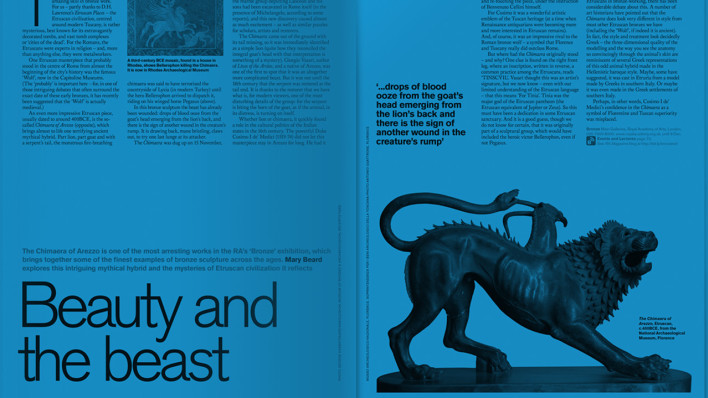
Enjoyed this article?
"As well as free entry to all of our exhibitions, Friends of the RA enjoy one of Britain’s most respected art magazines, delivered directly to your door. Why not join the club? "
Related articles
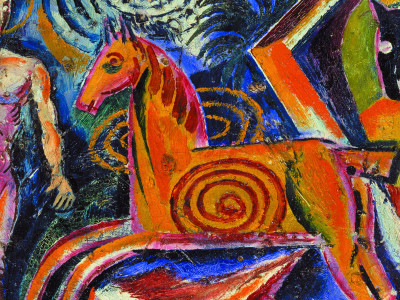
Visions from Ukraine
19 June 2024
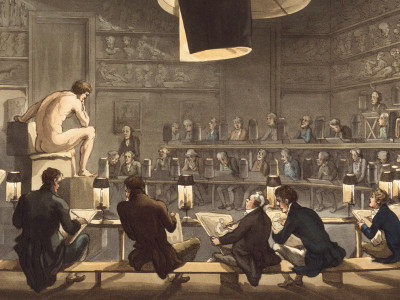
10 RA Schools stories through the centuries
16 May 2024
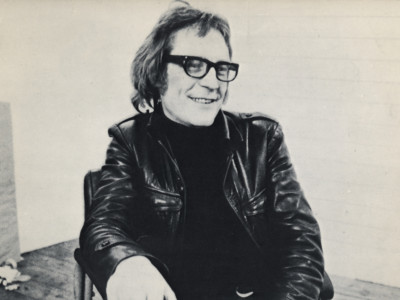
In memoriam: Mick Moon RA
1 May 2024